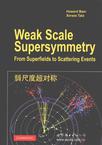弱尺度超对称
出版时间:2012-3 出版社:世界图书出版公司 作者:贝尔 页数:537
内容概要
超对称是自然界中一种新的对称性。本书全面系统地介绍了粒子物理学中的超对称,首先阐述了超对称的基本概念,接着展示了如何将超对称纳入到描述基本粒子的理论框架中。书中采用了高能物理实验学家和唯象学家们所熟悉的四分量旋量表示,从而使得本书的可读性大为增强。本书迅速地将读者从抽象描述带入到构造基本粒子的超对称性规范理论,并最终给出对撞机和宇宙学实验观测量的计算。本书与高能实验和唯象理论结合得非常紧密,这是本书的一大特色。对于从事粒子物理实验和唯象研究的物理学家和研究生而言,这是一本全面、实用且易懂的教学参考书,并且包括大量的练习和补充材料,非常合适作为超对称理论的入门教材。阅读本书需要一些基本的标准模型和量子场论知识。
读者对象:粒子物理、理论物理和场论等专业的高年级本科生、研究生和相关专业的科研人员。
作者简介
Howard Baer,美国佛罗里达州立大学J. D.
Kimel物理学教授,美国物理学会会士。1984在威斯康星大学获得理论物理博士学位,先后在欧洲粒子物理实验中心,阿贡国家实验室,佛罗里达州立大学做博士后。在基本粒子物理领域内发表了一百多篇学术论文。
Xerxes
Tata,美国夏威夷大学物理和天文学系教授,美国物理学会会士。在德克萨斯大学奥斯汀分校获得理论高能物理博士学位。先后在俄勒冈大学,欧洲粒子物理实验中心和威斯康星大学做博士后。在基本粒子物理领域内发表了一百多篇学术论文。
书籍目录
preface
the standard model
1.1 gauge invariance
1.2 spontaneous symmetry breaking
1.3 brief review of the standard model
2 what lies beyond the standard model?
2.1 scalar fields and quadratic divergences
2.2 why is the tev scale special?
2.3 what could the new physics be?
3 the wess-zumino model
3.1 the wess-zumino lagrangian
3.2 quantization of the wz model
3.3 interactions in the wz model
3.4 cancellation of quadratic divergences
3.5 soft supersymmetry breaking
the supersymmetry algebra
4.1 rotations
4.2 the lorentz group
4.3 the poincar6 group
4.4 the supersymmetry algebra
5 superfieid formalism
5.1 superfields
5.2 representations of symmetry generators: a recap
5.3 representation of susy generators as differential
operators
5.4 useful 0 identities
5.5 susy transformations of superfields
5.6 irreducible susy multiplets
5.7 products of superfields
5.8 supercovariant derivatives
5.9 lagrangians for chiral scalar superfields
5.10 the action as an integral over superspace
6 supersymmetric gauge theories
6.1 gauge transformations of superfields
6.2 the wess-zumino gauge
6.3 the curl superfield in the wess-zumino gauge
6.4 construction of gauge kinetic terms
6.5 coupling chiral scalar to gauge superfields
7 supersymmetry breaking
7.1 susy breaking by elementary fields
7.2 f-type susy breaking: the o'raifeartaigh model
7.3 d-type susy breaking
7.4 composite goldstinos
7.5 gaugino condensation
7.6 goldstino interactions
7.7 a mass sum rule
7.8 explicit supersymmetry breaking
7.9 a technical aside: ys-dependent fermion mass matrices
8 the minimal supersymlnetric standard model
8.1 constructing the mssm
8.2 electroweak symmetry breaking
8.3 particle masses in the mssm
8.4 interactions in the mssm
8.5 radiative corrections
8.6 should the goldstino be part of the mssm?
9 implications of the mssm
9.1 low energy constraints on the mssm
9.2 renormalization group equations
9.3 constraints from b → sy decay
9.4 bs → μ+μ- decay
9.5 muon anomalous magnetic moment
9.6 cosmological implications
9.7 neutrino masses
10 local supersymmetry
10.1 review of general relativity
10.2 local supersymmetry implies (super)gravity
10.3 the supergravity lagrangian
10.4 local supersymmetry breaking
11 realistic supersymmetric models
11.1 gravity-mediated supersymmetry breaking
11.2 anomaly-mediated susy breaking
11.3 gauge-mediated susy breaking
11.4 gaugino-mediated susy breaking
11.5 an afterword
12 sparticle production at colliders
12.1 sparticle production at hadron colliders
12.2 sparticle production at e+e- colliders
13 sparticle decays
13.1 decay of the gluino
13.2 squark decays
13.3 slepton decays
13.4 chargino decays
13.5 neutralino decays
13.6 decays of the higgs bosons
13.7 top quark decays to susy particles
13.8 decays to the gravitino/goldstino
14 supersymmetric event generation
14.1 event generation
14.2 event generator programs
14.3 simulating susy with isajet
15 the search for supersymmetry at coiliders
15.1 early searches for supersymmetry
15.2 search for susy at lep and lep2
15.3 supersymmetry searches at the tevatron
15.4 supersymmetry searches at supercolliders
15.5 beyond susy discovery
15.6 photon, muon, and very large hadron colliders
16 r-parity violation
16.1 explicit (trilinear) r-parity violation
16.2 spontaneous (bilinear) r-parity violation
17 epilogue
appendix a sparticle production cross sections
a.1 sparticle production at hadron colliders
a.2 sparticle production at e+e- colliders
appendixb sparticle decay widths
b.1 gluino decay widths
b.2 squark decay widths
b.3 slepton decay widths
b.4 neutralino decay widths
b.5 chargino clecay widths
b.6 top quark decay to susy particles
appendix c higgs boson decay widths
c.1 decays to sm fermions
c.2 decays to gauge bosons
c.3 decays to sfermions
c.4 decays to charginos and neutralinos
c.5 decays to higgs bosons
bibliography
index
章节摘录
版权页: 插图: At the one—loop level,however,a coupling of (H)u to down—type fermions is induced.This induced coupling leads to a new contribution,proportional to vu,tothe down—type fermion mass matrix.Although this contribution is suppressed bya loop factor relative to the tree—level contribution,this suppression is (partially)compensated if tan β is sufficiently large.As a result, down—type Yukawa interactions and down—type quark mass matrices are no longer diagonalized by the sametransformation,and flavor—violating couplings of neutral Higgs scalars h,H,and Aemerge.In the limit of large mA,the Higgs sector becomes equivalent to the Stan—dard Model (SM) Higgs sector with a light Higgs boson h () HSM,and the effectsof flavor violation decouple from the low energy theory.The interesting featureis that the flavor—violating couplings of h,H, and A do not decouple for largesuperparticle mass parameters:being dimensionless,these couplings depend onlyon ratios of these mass parameters,and so remain finite even for very large valuesof SUSY mass parameters.
编辑推荐
《弱尺度超对称:从超场到散射事例》是由世界图书出版公司北京公司出版的。
图书封面
评论、评分、阅读与下载
用户评论 (总计1条)
- 内容就不说了。印刷很不错。
